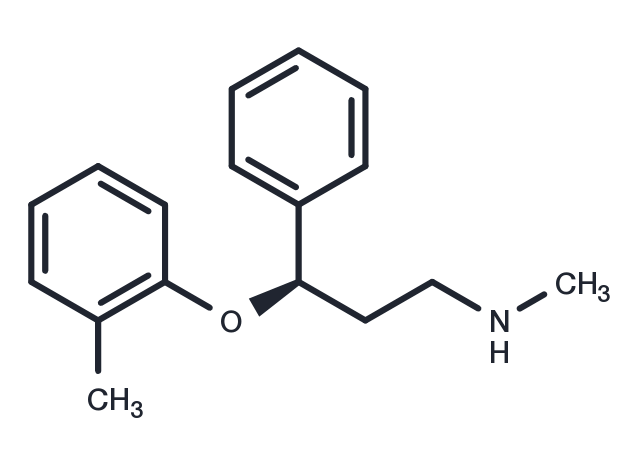store at low temperature
Powder: -20°C for 3 years | In solvent: -80°C for 1 year

Atomoxetine (HSDB 7352) is a selective norepinephrine inhibitor that may cause an increase in blood pressure by increasing norepinephrine concentrations in peripheral sympathetic neurons .Atomoxetine is a highly selective antagonist of presynaptic norepinephrine transporters with little or no affinity for other norepinephrine receptors or other neurotransmitter transporters or receptors, but has little or no affinity for 5- hydroxytryptamine transporter. Atomoxetine selectively inhibits reuptake of norepinephrine and can be used to treat adolescents with ADHD and chronic tics.

| Pack Size | Availability | Price/USD | Quantity |
|---|---|---|---|
| 25 mg | 6-8 weeks | $ 1,520.00 |

| Description | Atomoxetine (HSDB 7352) is a selective norepinephrine inhibitor that may cause an increase in blood pressure by increasing norepinephrine concentrations in peripheral sympathetic neurons .Atomoxetine is a highly selective antagonist of presynaptic norepinephrine transporters with little or no affinity for other norepinephrine receptors or other neurotransmitter transporters or receptors, but has little or no affinity for 5- hydroxytryptamine transporter. Atomoxetine selectively inhibits reuptake of norepinephrine and can be used to treat adolescents with ADHD and chronic tics. |
| Targets&IC50 | Norepinephrine:5 nM, 5-HT:77 nM, Dopamine:1451 nM |
| In vitro | Atomoxetine (Tomoxetine) exhibits state- and dose-dependent interaction with the human cardiac sodium channel (hNav1.5) in tsA201 cells, with concentrations ranging from 1 to 100 µM and exposure durations of 0.5 to 20 seconds.[2] |
| In vivo |
Administration of Atomoxetine (Tomoxetine) at doses of 0.3-3 mg/kg (i.p.) for a duration of 0-4 hours in male Sprague-Dawley rats results in a threefold increase in extracellular norepinephrine and dopamine levels, along with an increase in Fos expression observed in the prefrontal cortex.[1]
Furthermore, Atomoxetine (Tomoxetine) at doses of 0.1-5 mg/kg (i.p. and p.o.) administered over a period of 14 days in spontaneously hypertensive rats demonstrates the potential to ameliorate ADHD-related behaviors in rats.[3] |
| Synonyms | Tomoxetine, HSDB7352, HSDB-7352, HSDB 7352 |
| Molecular Weight | 255.35 |
| Formula | C17H21NO |
| CAS No. | 83015-26-3 |
store at low temperature
Powder: -20°C for 3 years | In solvent: -80°C for 1 year
DMSO: Soluble
You can also refer to dose conversion for different animals. More
bottom
Please see Inhibitor Handling Instructions for more frequently ask questions. Topics include: how to prepare stock solutions, how to store products, and cautions on cell-based assays & animal experiments, etc.
Atomoxetine 83015-26-3 Neuroscience Norepinephrine Tomoxetine HSDB7352 HSDB-7352 HSDB 7352 inhibitor inhibit
